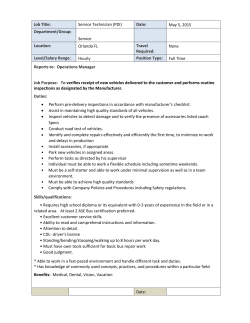
A comparative analysis of different Dilemma Zone - safer-sim
A comparative analysis of different Dilemma Zone countermeasures on signalized intersections’ safety based on Cellular Automaton Model TRB 15-1555 Yina Wu1, Yaoxian Ding2, Mohamed Abdel-Aty1, Bin Jia2 Data Preparation The data collection took place at a typical four-leg intersection in Orlando, FL. The data has been analyzed for driver behavior and red-light running violations in 2010, where 8 variables were included. Due to the small sample size of light truck vehicles, data of this vehicle type were excluded from the database in this study. The probability that a driver will decide to cross the intersection is modeled as logistic distribution in Eq. (1), where g x =0 stands for stopping and g x =1 stands for crossing: π x = Four scenarios were established, which includes the typical intersection signal, signal with flashing green phases, the intersection with pavement marking upstream of the approach, and the intersection with a new countermeasure: adding an auxiliary flashing indication next to the pavement marking. eg x 1+eg x 30,5 =𝛽0 + 𝛽1 𝑥1 + 𝛽2 𝑥2 + 𝛽3 𝑥3 +. … . . +𝛽𝑛 𝑥𝑛 The logistic model is found to be appropriate for the data (Hosmer-Lemeshow goodness of fit Chi-square =2.7349, d.f.=8, p-value=0.9499). The ROC area of 0.874 indicated that 87.4% of (go, stop) pairs of decisions were classified correctly by the model that means the predictive accuracy is good. Four risk situations are analyzed in this study, which includes slam on the brake, situations caused by stopped car, non-stopped cars and Red-Light Running Rate (RLR). P-DS1 g x = 40,5 50,5 60,5 50,2 50,10 Speed Distribution of Lead Vehicles The Logit of the logistic regression model is given by : π x ln 1−π x 0.0016 0.0014 0.0012 0.001 0.0008 0.0006 0.0004 0.0002 0 Results and Discussion The mean speed or standard deviation can influence the BRAKE & RS2 risk probabilities. The flashing green countermeasure does not improve safety significantly, Distinction between the typical intersection scenario and the flashing green scenario is probably due to the increase of the indecision period when drivers behave differently. especially under the situations of high mean speed or low standard deviation of speed distribution. The rear-end risk probabilities are even higher than the typical intersection. 0.0009 0.0008 0.0007 0.0006 0.0005 0.0004 0.0003 0.0002 0.0001 0 40,5 50,5 60,5 50,2 Speed Dstribution of Lead Vehicles 50,10 0.00006 0.00005 0.00004 0.00003 0.00002 0.00001 Parameter Estimate Odds Ratio 95% Wald Confidence Limits Wald 𝛘𝟐 Pr > ChiSq 0 30,5 Follow vs. Lead 0.9458 2.547 1.870 3.469 35.8336 <.0001 2 vs. 1 3 vs. 1 40,5 50,5 60,5 50,2 Speed Dstribution of Lead Vehicles 50,10 0.3 Speed Group 0.25 1.4994 3.2820 4.479 26.629 2.974 14.837 6.746 47.793 51.4817 120.9566 <.0001 <.0001 The simulation results suggest that the flashing green phase measure cannot effectively decrease the percentage of false decisions by drivers. The RLR violation is significant when the mean speed of the leading vehicles is lower than 50mph or the standard deviation of the speed distribution is high in the pavement-marking scenario. Thus, a new countermeasure is proposed. The results show that the intersection with the new countermeasure has less rear-end risk situations and rare RLR violations. Summary and Conclusion 30,5 0.2 P-RLR This research evaluated driver behavior during the yellow interval at signalized intersections. Based on field data, a logistic regression model, which is a function of speed, distance to the stop line and the lead/follow position of the vehicle, was developed to predict driver stop/go decisions. Meanwhile, three different simulation scenarios were established, including the typical intersection signal, signal with flashing green phases, and intersection with pavement marking upstream of the approach. The Cellular Automata (CA) model was employed to simulate the traffic flow, and the logistic regression model was applied as the stop/go decision rule. Dilemma situations that lead to rearend crash risks and potential red-light running risks were used to evaluate the different scenarios. The findings indicated that the flashing green could not effectively reduce the risk probabilities. The pavement-marking countermeasure had positive effects on reducing the risk probabilities if a platoon’s mean speed was not under the speed used for designing the pavement marking. Otherwise, the risk probabilities for the intersection would not be reduced because of the increase in the red-light running (RLR) rate. A new measure that adds a flashing indication next to the pavement marking was proposed. The simulation results showed that this scenario had less risky situations than the other scenarios with the same speed distribution. These findings suggested the effectiveness of the new countermeasure to reduce both rear-end collisions and red-light running violations than other countermeasures. Statistical Modeling and Simulation P-DS2 Overview P-Brake 1 Department of Civil, Environmental & Construction Engineering, University of Central Florida, Orlando, Florida 2 MOE Key Laboratory for Urban Transportation Complex Systems Theory and Technology, Beijing Jiaotong University, Beijing, China 0.15 Driver behavior during the yellow interval is influenced by operation speed, distance to the stop line as well as lead or follow position in a platoon. The mean speed and standard deviation play a significant role in rear-end crash risk situations. The flashing green countermeasure has little influence on rear-end risk reduction. The pavement-marking countermeasure can effectively decrease the rear-end crash risk and improve safety in most situations. The flashing green phases cannot reduce the percentage of false go decisions. The pavement marking can effectively reduce the RLR risky situations when the vehicles are approaching the intersection with high speed and low speed difference with other vehicles. The new countermeasure has the lowest rear-end crash risks compared with other scenarios with the same speed distribution, and it has rare RLR violation. Acknowledgment 0.1 Distance Group 2 vs. 1 0.05 -2.4108 0.090 0.063 0.128 174.7836 <.0001 0 30,5 3 vs. 1 4 vs. 1 -4.5557 -5.2498 0.011 0.005 0.005 0.002 0.022 0.013 141.3785 122.3220 <.0001 <.0001 typical scenario 40,5 50,5 60,5 50,2 Speed Distribution of Lead Vehicles flashing green senario 50,10 pavement-marking senario This work is financially supported by the National Basic Research Program of China (no. 2012CB725400), The National Natural Science foundation of China (71222101, 71210001). The authors also wish to thank the Florida Department of Transportation and the University of Iowa lead tier 1 UTC Safety Research using Simulation (SAFER-SIM) for partly funding this research.
© Copyright 2025









